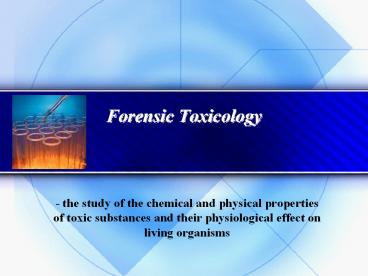Forensic Toxicology PowerPoint PPT Presentation
1 / 23
Title: Forensic Toxicology
1
Forensic Toxicology
- - the study of the chemical and physical
properties of toxic substances and their
physiological effect on living organisms
2
Three Primary Responsibilities
- Postmortem Drug Testing
- Workplace Drug Testing
- Identification of Contraband Materials
3
Deaths Investigated by Toxicologists
- Accidental Poisonings
- Drug Abuse Cases
- Suicidal Poisonings
- Homicidal Poisonings
4
Deaths Investigated by Toxicologists
- Accidental Poisonings
- Drug Abuse Cases
- Suicidal Poisonings
- Homicidal Poisonings
5
Toxicological Analysis of Tissue
- Collect sample of all body fluids
- Collect samples from organs and tissues
- A forensic toxicologist cannot simply look for
the presence of a toxin or drug in a body, she
must understand how the body processes these
molecules - Toxicological analysis must start as soon as
possible after a persons death
6
Toxicological Analysis of Tissue
- Collect sample of all body fluids
- Collect samples from organs and tissues
- A forensic toxicologist cannot simply look for
the presence of a toxin or drug in a body, she
must understand how the body processes these
molecules - Toxicological analysis must start as soon as
possible after a persons death
7
General Classes of Poisons
- Gases
- Metallic Poisons
- Volatile Organics
- Non-volatile Organics
- - the major category here is what is known as an
alkaloid, a drug that mimics human
neurotransmitters or hormones and therefore
interferes with normal body chemistry - Alkaloids are derived from plants
8
Alkaloids
- Common Examples
- Amphetamines stimulants that provoke euphoria
these drugs mimic catecholamines in the human
body (adrenaline, etc) - Cocaine natural stimulant that acts as a mimic
to catecholamines metabolites are detected in
urine for as many as 3 days - Opiates depressants that reduce muscle
activity, heartbeat, respiration, and the
inclination to sleep effective pain relievers
and euphoria producing opiates mimic endorphins
in the human body - Cannabinoids fast acting plant alkaloid body
mimic is unknown metabolites can be detected in
urine for months
9
Alkaloids
amphetamine
adrenaline
cocaine
serotonin
ecstasy
10
Methods of Detection
- Color test
- Microdiffusion test
- Chromatography
- a. thin-layer chromatography (TLC)
- b. gas chromatography (GC)
- c. high performance liquid chromatography (HPLC)
- Spectroscopy
- a. UV light d. X-ray
- b. visible light e. infrared
- c. microwave
11
Methods of Detection
- Color test
- Microdiffusion test
- Chromatography
- a. thin-layer chromatography (TLC)
- b. gas chromatography (GC)
- c. high performance liquid chromatography (HPLC)
- Spectroscopy
- a. UV light d. X-ray
- b. visible light e. infrared
- c. microwave
12
Methods of Detection
- Color test
- Microdiffusion test
- Chromatography
- a. thin-layer chromatography (TLC)
- b. gas chromatography (GC)
- c. high performance liquid chromatography (HPLC)
- Spectroscopy
- a. UV light d. X-ray
- b. visible light e. infrared
- c. microwave
13
Methods of Detection
- Color test
- Microdiffusion test
- Chromatography
- a. thin-layer chromatography (TLC)
- b. gas chromatography (GC)
- c. high performance liquid chromatography (HPLC)
- Spectroscopy
- a. UV light d. X-ray
- b. visible light e. infrared
- c. microwave
14
Methods of Detection
- Color test
- Microdiffusion test
- Chromatography
- a. thin-layer chromatography (TLC)
- b. gas chromatography (GC)
- c. high performance liquid chromatography (HPLC)
- Spectroscopy
- a. UV light d. X-ray
- b. visible light e. infrared
- c. microwave
15
(No Transcript)
16
Methods of Detection
- Color test
- Microdiffusion test
- Chromatography
- a. thin-layer chromatography (TLC)
- b. gas chromatography (GC)
- c. high performance liquid chromatography (HPLC)
- Spectroscopy
- a. UV light d. X-ray
- b. visible light e. infrared
- c. microwave
17
Example UV-vis Spectrum
18
Methods of Detection
- Color test
- Microdiffusion test
- Chromatography
- a. thin-layer chromatography (TLC)
- b. gas chromatography (GC)
- c. high performance liquid chromatography (HPLC)
- Spectroscopy
- a. UV light d. X-ray
- b. visible light e. infrared
- c. microwave
19
Example IR Spectrum
20
Methods of Detection
- Mass Spectroscopy
- Immunoassay
21
(No Transcript)
22
Methods of Detection
- Mass Spectroscopy
- Immunoassay
23
Interpretation of Findings
- Is a drug or poison present? What substance?
- How much of the substance is present? Is its
concentration in the body sufficient to cause
death? - How was the drug/poison administered?

